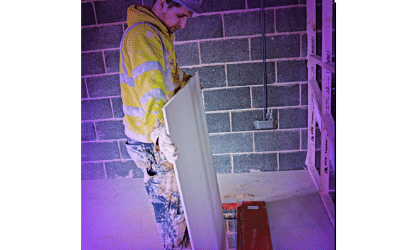The guide was produced by members of the Plasterboard Material Handling Group, which comprises representation from key suppliers, specialist and main contractors in the finishes and interiors sector and the Home Builders Federation (HBF), and is chaired by FIS Technical Director Joe Cilia. Created on behalf of the Health in Construction Leadership Group (HCLG), the Best Practice Guide looks at ways to improve safety when planning for the delivery and movement of plasterboard at each stage and how risks can be reduced.
Commenting on the launch of the guide, FIS chief executive Iain McIlwee said: “Musculosketal disorders (MSDs) cost construction employers £646 million a year and is one of the most common causes of sickness absence and productivity loss at work. The FIS Best Practice Guide, Recommendations for the Safe Ingress of Plasterboard provides clear recommendations on ways to reduce the risk of injury and improve productivity and working conditions on site.”
The aim of the guide is to improve health and safety when plasterboard is delivered, moved and stored. It covers material-handling arising from the journey that plasterboard takes when delivered to sites that include homes, commercial, high-rise multi-occupancy, new builds and refurbishments. The guide is broken down into stages from planning to engagement with manufacturers and distributors, delivery and offloading, storage, vertical and horizontal movement, storage of off-cuts and finally the removal and egress of waste.
“Training, planning and good working practices will ensure that people can work in the industry until they wish to leave it with good health and not have to leave the industry because of debilitating musculoskeletal problems,” added Professor Anthony Woolf of the Bone and Joint Research Group at the Royal Cornwall Hospital, who provided expert advice to the group.
Ian Strudley, who is Chair of the HCLG MSD Task Group and Occupational Health and Hygiene Specialist at Balfour Beatty, said: “This comprehensive guide to the movement and handling of plasterboard will help consolidate the effort to achieve further improvements in musculoskeletal health, and therein achieve additional risk reduction and greater productivity.”
A spokesperson for the HSE said: “Musculoskeletal disorders (MSD) are one of the most common work-related ill health conditions. Reducing the incidence and impact of these on workers’ health is a strategic priority for HSE. Poor materials handling commonly results in MSDs as well as more acute injuries. The construction sector has one of the highest rates of MSDs, and they are amongst the most common cause of sickness absence.
HSE acknowledges the launch of the HCLG’s report and guidance on reducing MSD during the delivery and movement of Plasterboard, and supports the collaborative work of the industry in reducing the incidence of MSDs.”
The HCLG comprises of contractors, clients, professional bodies, trade associations and trade unions. It is supported by the HSE (Health and Safety Executive).
FIS represents suppliers and contractors in the finishes and interiors sector. Its contractor members workmanship is vetted when they join and then every three years and they agree to carry out work in accordance with the FIS best practice guides. All members abide by a code of conduct. A searchable list of members can be found here:

